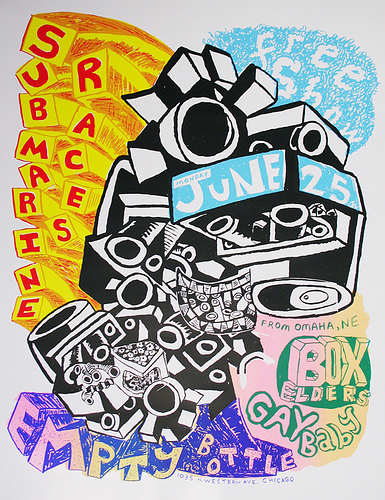The first time I saw work by the Providence upstarts then known only by the name of their communal live/art space, Fort Thunder—guys like Ben Jones and Leif Goldberg, who ended up as founding members of Forcefield. Paper Rad, etc. – it was at a huge rock poster show put on at Chicago’s Butcher Shop in 1999. Their posters were expressionistic, but exquisitely detailed and highly crafted; they were known for having far more color separations in their silkscreen prints than anyone else in the show. They were more pretty than weird then. The crest of acclaim that buoyed that gang in the ‘oughts followed the arc of many frisky artists brought to heel by MFA degrees and attention from the Whitney Biennial— visionary anarchism whittled down to a few key motifs (diamonds, peace signs, weird dog heads, Gumby) and a trademark style (day-glo colors, seizure-strobe animations).
And I also saw Keith Herzik’s art for the first time in that Butcher Shop show. Keith’s work, on the other hand, had the mind-blowing audacity of the apparently feeble-minded; the trembling outlines of one little piece featured a toilet sitting on the lap of a large naked person, with a cutaway view to a pack of cigarettes rotting in their stomach. And yet, other artists treated Keith as the unsung celebrity of an incredibly comprehensive and star-studded survey exhibit. His posters were, compared to most of the art in that show, not especially offensive, clever, ornate, or vivid. Rather, like the musical output of Syd Barrett, they were gentle koans of incomparably absurd perfection.
Keith and the Providence dudes have had an ongoing artistic relationship, so the comparison isn’t shocking. Among other things, he contributed work to their stellar comics periodical Paper Rodeo back in the gay ‘90s. Since that time, the dudes have made the compromises necessary to become collectible cultural content, somewhat to their detriment, and Keith, well, he just hasn’t. Drawings that look like something David Crosby would have drawn with a pen in his mouth during a sentimental bout of flashback-induced somnambulism melt and wobble next to hysterically mundane sound bites, the same today as they did a decade ago. But his production values have advanced tremendously. The ecstatic drawings are scattered and stacked in delicate arrangements of ink separations that don’t belie the spontaneity of the epileptic doodling, but make it leap off the page in a joyful storm. His posters, once merely loopy, hilarious, and bizarre, have become retina-tingling tableaux of feverish shapes, harmonious chromatic energy, and enigmatic cultural bloopers. Herzik learned everything there was to learn from alterna-comics oracle Gary Panter, except how to try to age gracefully via obnoxious literary pretentions.
The sense of fragmentation is unavoidable in Herzik’s work, as images drift in and out of discernibility. In the small fully-screenprinted booklets he’s been making of late, under the aegis of “Alamo Igloo,” the format implies a narrative. Words appear now and then, there are a few recognizable and repeated images (dogs, astronauts with guns, sexy girls, etc.), but mostly the images dissolve into musical shapes and patterns, recalling the synesthetic synthesis of the arts that was one of Modernism’s nobler aims. In Concerning the Spiritual in Art, Wassily Kandinsky comments that “a first encounter with any new phenomenon exercises immediately an impression on the soul.” The effect is similarly immediate in Keith’s art, no hesitation in his eternally newborn overflow of sensations. Working tirelessly, never neglecting his handicraft, Herzik attempts to recreate the assault on the nervous system of a universe too strange to reproduce with detachment.
Keith is not a romantic narcissist—the impression from seeing the work is classically sublime, one of being overwhelmed and absorbed by reality, “to the point where one no longer sees forms or even matters,” (quoting Deleuze commentator Daniel W. Smith) “but only forces, densities, intensities; the forces of folding in a mountain, the forces of germination in an apple, the thermal and magnetic forces of a landscape.“ Vitalistic and demented, elegant and incoherent, immersive and marginal, these are pieces at which you stare like blinding headlights, and then stumble away from, forgetting everything but the floating spots briefly burned into your imaginations.
__________
Note by Noah: Bert first wrote the piece above for Paul Nudd’s dvd-r zine “R.U.B. Vol 2: Keith Herzik – Inside the Alamo Igloo,” which featured a 30-min documentary on Keith Herzik. This piece is also being used in the catalog for the Keith Herzik retrospective currently at the Hyde Park Arts Center, curated by Paul Nudd. If you are anywhere near Chicago, you need to see it.




